King Psammetichus II (Psamtik II)
King Psammetichus II (Psamtik II) of Egypt's 26th Dynasty
Of the Late Period Pharaohs prior to the Persian Conquest of Egypt, some are fairly well known to us, while others are not. Of this latter group, Psammetichus II (Psamtik II) must be included. His birth name was Psamtik, while his throne name was Neferibre, meaning "Beautiful is the Heart of Re".
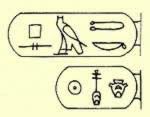
Psammetichus II was almost certainly the son of Nekau (Necho) probably by a Queen Chedebnitjerbone I. He ascended to the throne of Egypt we believe as the third king of Egypt 26th Dynasty (Saite Dynasty), probably in the year 595 BC at a time when Egypt was traveling down the road to eventual decline, though his reign is seen as a short respite; a reversal of his father's misfortunes. He probably only ruled for a period of about six years. We know a little about his family. He married a Queen Takhout (Takhut) of Athribis who provided him with a daughter named Ankhnesneferibre. We also know of a princess Herynebti Menekhoubaste and of course, Apries (Wahibre Haaibre), who succeeded him on the throne.
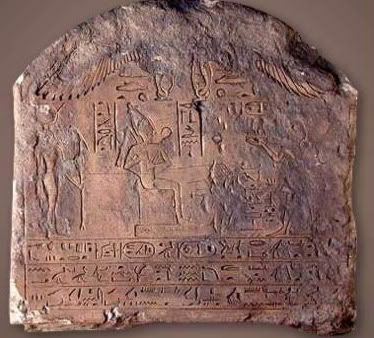
Limestone quarries in the Makattam Hills near Cairo were clearly worked during this king's reign.He may have founded the temple at Hibis in the El-Kharga Oasis, and the oldest known remains at Philae belong to his reign. It seem that he made additions to the Temple of Neith at Sais, monuments at Ausim (Letopolis) and the Temple at El-Mahalla el-Kubra, and blocks from his reign have also been found at Abydos, Karnak (where he also usurped the kiosk of Taharqa), Elephantine and El-Naharya.
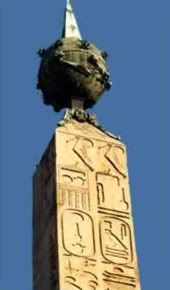
Perhaps the best known of his monuments, originally erected at Heliopolis as one of two, was an obelisk that was carried off to Rome by Augustus, who placed it as a sundial in a vast square (Horologium Divi Augusti) where its shadow indicated the hours of the day and the days of the year. It was found broken into five pieces in 1748. It was later repaired, and in 1789, Pius VI moved the obelisk to Piazza di Montecitorio where it was put on top of what remained of a column erected by Antoninus Pius. There, he crowned it with a reminder that it had once been used as a sundial.
We also know that Psammetichus II led a foray into Nubia in 592, marching as far south as the Third or even the Fourth Cataract. A well known graffito inscribed in Greek on the left leg of the colossal seated statue of Ramesses II, on the south side of the entrance to the temple of Abu Simbel, records that:
"When King Psammetichus came to Elephantine, this was written by those who sailed with Psammetichus the son of Theocles, and they came beyond Kerkis as far as the river permits. Those who spoke foreign tongues (Greek and Carians who also scratched their names on the monument) were led by Potasimto, the Egyptians by Amasis."
The military leaders mentioned in this reference are also known to us from other sources. This was the first confrontation between Egypt and Nubia since the time of Tantamani. A Kushite king named Anlamani had revived the kingdom of Napata, and according to Egyptian records, the campaign during Psammetichus II's reign was made in order to put down a Nubian rebellion, though in fact it may have been due as much to the foreign aspirations of the Pharaoh as much as any Kushite attempt to reconquer Egypt.
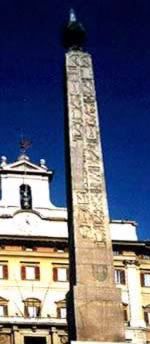
The Egyptian army seems to have advanced to Pnubs and according to Reisner, perhaps Napata, where they looted the temples and destroyed the royal Kushite statues. As a result, Kush's power was crushed, and their kings had no real possibility of ever regaining control of Egypt. In fact, they seem to have been pushed to remove their capital further south. Curiously, however, Psammetichus II does not appear to have capitalized much on his victory. His troops retreated back to the First Cataract, and Elephantine continued to be the southern border of Egypt. One outcome of this campaign was the deliberate slighting of monument, not only of the 25th Dynasty Kushite kings, but unexplainably, also of Psammetichus II's father, Necho. In addition, another foray was made under Psammetichus II during the following year into southern Palestine. In 602 BC, Jehoiakim of Jerusalem rebelled against Babylon. However, after his son, Jehoiachin succeeded him in 598, Jerusalem was almost immediately recaptured by Nebuchadrezzar II, who pillaged the temple and deported the new Judah ruler to Babylon, replacing him with Zedekiah, Jehoiachin's uncle. Though Jehoiachin remained in exile for thirty-seven years, his supporters constantly struggled against Zedekiah. Psammetichus II's campaign, that was perhaps more peaceful then otherwise, though recorded as a traditional military campaign, encouraged Zedekiah to embark upon a rebellion that ultimately proved to be catastrophic for Jerusalem when the city fell in 587 BC.
At home, we also know that Psammetichus II made sure that Ankhnesneferibre (Neferibre lives for her), his daughter, by a Queet Takhut, was adopted by the Divine Adoratice Nitocris, who she eventually succeeded as Wife of Amun at Thebes in 584. Ankhnesneferibre managed to hold this office until the Persian conquest of Egypt in 525 BC. Otherwise, there were some magnificent tombs, such as those of the Stewards of Amun, Shoshenq son of Harsiese (TT27) Padineith (TT197) and Ankh-hor (TT414) that attest to the fact that there was a certain amount of wealth and splendor during this king's reign.
Psammetichus II is believed to have died in February of 589 BC, and was succeeded by his son, Apries.
Se Also :
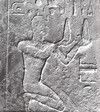
Psammetikhos I ,first ruler of the 26th Dynasty
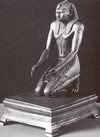
Nekau II, of Egypt's 26th Dynasty
Of the Late Period Pharaohs prior to the Persian Conquest of Egypt, some are fairly well known to us, while others are not. Of this latter group, Psammetichus II (Psamtik II) must be included. His birth name was Psamtik, while his throne name was Neferibre, meaning "Beautiful is the Heart of Re".

Psammetichus II was almost certainly the son of Nekau (Necho) probably by a Queen Chedebnitjerbone I. He ascended to the throne of Egypt we believe as the third king of Egypt 26th Dynasty (Saite Dynasty), probably in the year 595 BC at a time when Egypt was traveling down the road to eventual decline, though his reign is seen as a short respite; a reversal of his father's misfortunes. He probably only ruled for a period of about six years. We know a little about his family. He married a Queen Takhout (Takhut) of Athribis who provided him with a daughter named Ankhnesneferibre. We also know of a princess Herynebti Menekhoubaste and of course, Apries (Wahibre Haaibre), who succeeded him on the throne.

Limestone quarries in the Makattam Hills near Cairo were clearly worked during this king's reign.He may have founded the temple at Hibis in the El-Kharga Oasis, and the oldest known remains at Philae belong to his reign. It seem that he made additions to the Temple of Neith at Sais, monuments at Ausim (Letopolis) and the Temple at El-Mahalla el-Kubra, and blocks from his reign have also been found at Abydos, Karnak (where he also usurped the kiosk of Taharqa), Elephantine and El-Naharya.

Perhaps the best known of his monuments, originally erected at Heliopolis as one of two, was an obelisk that was carried off to Rome by Augustus, who placed it as a sundial in a vast square (Horologium Divi Augusti) where its shadow indicated the hours of the day and the days of the year. It was found broken into five pieces in 1748. It was later repaired, and in 1789, Pius VI moved the obelisk to Piazza di Montecitorio where it was put on top of what remained of a column erected by Antoninus Pius. There, he crowned it with a reminder that it had once been used as a sundial.
We also know that Psammetichus II led a foray into Nubia in 592, marching as far south as the Third or even the Fourth Cataract. A well known graffito inscribed in Greek on the left leg of the colossal seated statue of Ramesses II, on the south side of the entrance to the temple of Abu Simbel, records that:
"When King Psammetichus came to Elephantine, this was written by those who sailed with Psammetichus the son of Theocles, and they came beyond Kerkis as far as the river permits. Those who spoke foreign tongues (Greek and Carians who also scratched their names on the monument) were led by Potasimto, the Egyptians by Amasis."
The military leaders mentioned in this reference are also known to us from other sources. This was the first confrontation between Egypt and Nubia since the time of Tantamani. A Kushite king named Anlamani had revived the kingdom of Napata, and according to Egyptian records, the campaign during Psammetichus II's reign was made in order to put down a Nubian rebellion, though in fact it may have been due as much to the foreign aspirations of the Pharaoh as much as any Kushite attempt to reconquer Egypt.

The Egyptian army seems to have advanced to Pnubs and according to Reisner, perhaps Napata, where they looted the temples and destroyed the royal Kushite statues. As a result, Kush's power was crushed, and their kings had no real possibility of ever regaining control of Egypt. In fact, they seem to have been pushed to remove their capital further south. Curiously, however, Psammetichus II does not appear to have capitalized much on his victory. His troops retreated back to the First Cataract, and Elephantine continued to be the southern border of Egypt. One outcome of this campaign was the deliberate slighting of monument, not only of the 25th Dynasty Kushite kings, but unexplainably, also of Psammetichus II's father, Necho. In addition, another foray was made under Psammetichus II during the following year into southern Palestine. In 602 BC, Jehoiakim of Jerusalem rebelled against Babylon. However, after his son, Jehoiachin succeeded him in 598, Jerusalem was almost immediately recaptured by Nebuchadrezzar II, who pillaged the temple and deported the new Judah ruler to Babylon, replacing him with Zedekiah, Jehoiachin's uncle. Though Jehoiachin remained in exile for thirty-seven years, his supporters constantly struggled against Zedekiah. Psammetichus II's campaign, that was perhaps more peaceful then otherwise, though recorded as a traditional military campaign, encouraged Zedekiah to embark upon a rebellion that ultimately proved to be catastrophic for Jerusalem when the city fell in 587 BC.
At home, we also know that Psammetichus II made sure that Ankhnesneferibre (Neferibre lives for her), his daughter, by a Queet Takhut, was adopted by the Divine Adoratice Nitocris, who she eventually succeeded as Wife of Amun at Thebes in 584. Ankhnesneferibre managed to hold this office until the Persian conquest of Egypt in 525 BC. Otherwise, there were some magnificent tombs, such as those of the Stewards of Amun, Shoshenq son of Harsiese (TT27) Padineith (TT197) and Ankh-hor (TT414) that attest to the fact that there was a certain amount of wealth and splendor during this king's reign.
Psammetichus II is believed to have died in February of 589 BC, and was succeeded by his son, Apries.
Se Also :

Psammetikhos I ,first ruler of the 26th Dynasty

Nekau II, of Egypt's 26th Dynasty

Δεν υπάρχουν σχόλια:
Δημοσίευση σχολίου